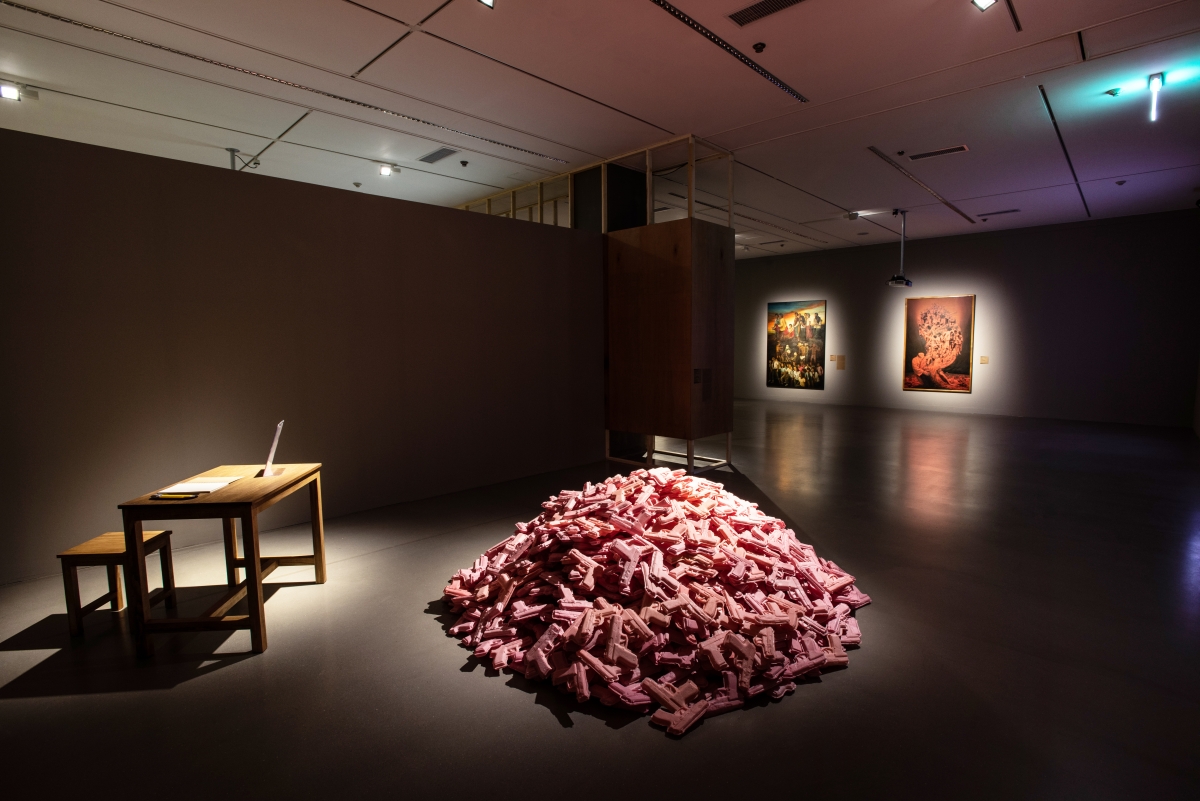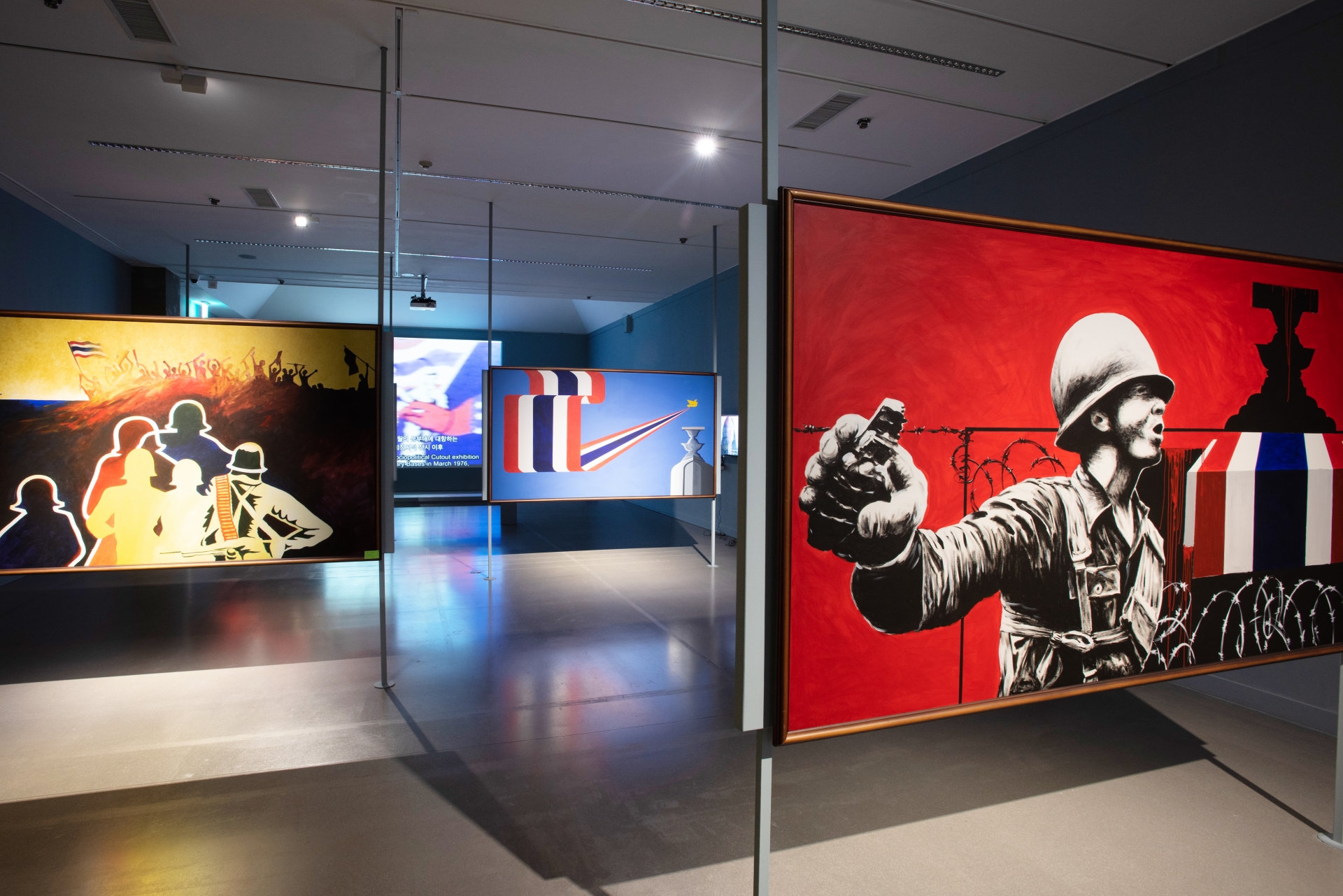‘Awakenings: Art in Society in Asia 1960s –1990s’ was planned to re-examine the history of Asian contemporary art in the context of Asia. It presents 170 works by significant artists from 13 Asian countries (Japan, China, Taiwan, Hong Kong, Singapore, Indonesia, Philippines, etc.) and analyses the unique art history of each country. The project was carried out with the cooperation of four organisations: The National Museum of Modern and Contemporary Art of Korea (MMCA), the National Museum of Modern Art, Tokyo (MOMAT), the National Gallery Singapore, and the Japan Foundation Asian Center. The curators of the exhibition conducted a joint on-site survey and shared the knowledge and perspectives needed for this kind of comparative approach. They also paid attention to subtle differences in the terminology used in each country.
On the opening day of the exhibition, an associated forum was held. This offered the opportunity for exhibition curators from various organisations to participate and talk about curatorial intentions, research details, and notable works in the exhibition.
Figurative Paintings with Social Narratives
The first speaker, Suzuki Katsuo (curator, MOMAT), talked about ‘the revival of Asian art history’. ‘We are trying to build a bridge between social realism and experimental art’, Suzuki said, raising the issues behind the traditional approach of analysing Asian modern art according to these two trends. According to him, in the Asian region, in which modern nations were established or cemented after the end of World War II, a movement took place in the 1960s that emphasised national identity. The interest of artists, as a result, expanded from individual work to everyday life and society, motivated by the desire to actively engage with reality. It means the tendency to break the boundaries between life and art, and to regard artists’ intervention in reality, as important.
In this atmosphere, Suzuki noted, the narrativity of paintings has seen a revival. At that time, under the influence of Europe and the United States, informalism, abstract expressionism, and minimalism were sweeping the art scene of Asia’s liberal countries. In response, some artists and critics have turned their eyes to the form of figurative art, while criticising those as entirely unrealistic. Suzuki cited South Korean art movement group ‘Reality and Utterance’, the Philippines’ ‘Kaisahan’ and the Indian artists who participated in the exhibition ‘Place for People’, as key examples.
In the paintings of the Reality and Utterance, countryside landscapes are juxtaposed with modern advertising images. In the illustrations of Kaisahan, the artist group using the languages of the mural, images of troops, barracks, and multinational company logos, many cultural registers are displayed together. In the picture featured in ‘Places for People’, a variety of times and spaces were mixed, appearing on one screen. These works seem to be figurative, but they have different meanings from those of socialist realism, which is based on a particular notion of reality. This is because these works invent new narratives through image montage. This technique was an attempt to better visualize and understand a world increasingly shaped by rapid rates of modernisation and urbanisation. Suzuki argued, ‘in this regard, Asian figurative paintings appear to be conceptual texts with something to read in itself. The figurative paintings induced the participation (reading) of the audience to restore their subjectivity, and promoted the revival of narrativity in art.’ ‘Social critical art from the 1960s to 1990s has emerged as a trend’, he added, ‘and visual symbols appearing in figurative paintings have also been found in performances and installation’.
Avant-Garde Art in a Dark Period
Adele Tan (senior curator, National Gallery Singapore) and Masuda Tomohiro (curator, MOMAT) discussed avant-garde art through the focus of China and the Philippines. First, Tan introduced the ‘China/Avant-Garde’ exhibition in ‘Making Sense of 1989 and its Aftermath’. According to Tan, the exhibition is addressed as a turning point in Chinese contemporary art: 190 artists participated and 300 works were exhibited. The ‘China/Avant-Garde’ was held on Feb. 5 1989 at the National Art Museum of China. The show, which was conducted with government approval at a time when political tensions were escalating, was halted just two hours after it began. The Chinese police withdrew the works because the performance was conducted without notice, and, above all, because of Lu Xiao’s controversial performance Dialogue. The performance consisted of firing illegally acquired guns toward two telephone booths, each with a picture of a man and a woman. The meaning – of the objects and the act of pulling the trigger at the performance – was unclear, but the authorities accepted it as a resistance against the government, detained the artist and closed the exhibition.
This shows that avant-garde art does not always stay in rebellion against established forms or artistic trends, in pursuit of new concepts. In other words, in Asia of the 1960s and 1990s avant-garde art was often followed or promoted by socio-political figures. ‘At the time, avant-garde arts activities were mostly guerrilla without government permission, and artists tried to come out into urban space and deliver something beyond work, rather than exhibiting works in galleries’, explained Tan.
Masuda Tomohiro paid attention to Jose Maceda, a music anthropologist and composer in the Philippines. Jose Maceda, born in Manila of the Philippines, studied piano and composition in the United States and earned a doctorate in music anthropology. He later studied folk music of the Philippines, Southeast Asia, East Asia, at National University of the Philippines.
Cassettes 100 (1979) is a work of performance art that is considered one of his major works. The work was premiered a year before President Ferdinando Marcos declared martial law and was held in the lobby of Cultural Center of the Philippines (CCP). Maceda had 100 players walking around the lobby with cassette players. The cassette players contained the music recording of native musical instruments and human voices, which were simultaneously played at the beginning of the performance and stopped 30 minutes later. Of this work, Masuda claimed, ‘unlike the conventional form of a music performance that separates the stage from the audience, the performer and the audience who played the cassette player have influenced each other and created a new experience’. He added, ‘it was very experimental, following the Western avant-garde music format, while also using native music from the Philippines’.
The assessment of the work becomes complex, considering the historical and social contexts surrounding the practice. The CCP, where the performance was performed, was built with the sponsorship of the First Lady of the President. Concerts, plays, dances were performed here under the auspices of the dictatorial regime, seeking to unify the nation’s identity. Maceda’s works, however, also reveals criticism of and resistance to the political situation: ‘Jose Maceda’s work has a contradictory and complex context. His approach and attitude to art have a point of connection with the work of artists who lived in different places and at different times’, said Masuda.
A Trajectory Overlapping Common Experience
From figurative painting to experimental art, contemporary art scenes from 1960s to 1990s were different from one country to another; nevertheless the works produced in similar political and social experiences are somewhat similar. This is why one might wonder if there was any exchange between artists or groups. ‘There seem to have been no direct meetings or interaction between works. However, the unexpected
resonance with similar social experiences can certainly be found’, said Seng Yujin (senior curator, National Gallery Singapore). Seng also mentioned, ‘Looking at the Philippine art group Kaisahan’s declaration, there are signs of accepting and sharing socialist ideas such as Lenin, Marx and Mao Zedong’s, and there will always be interplay in this way, links to historical aspects’.






